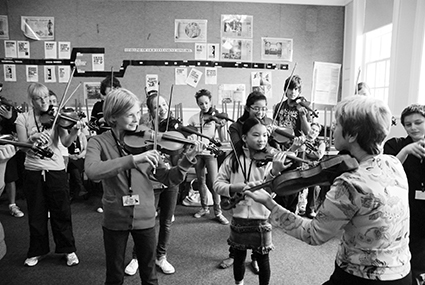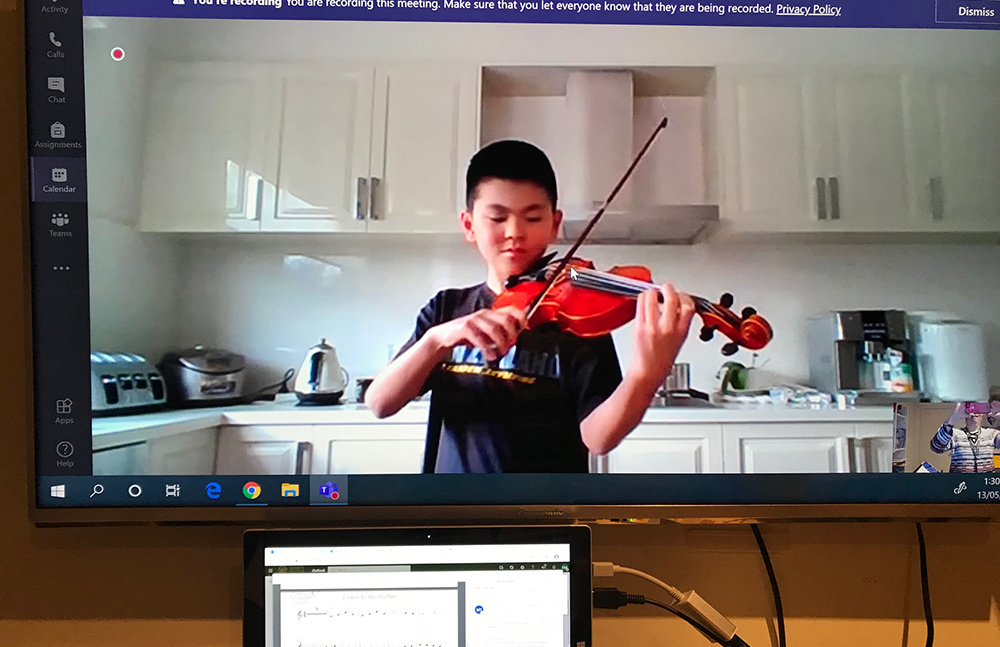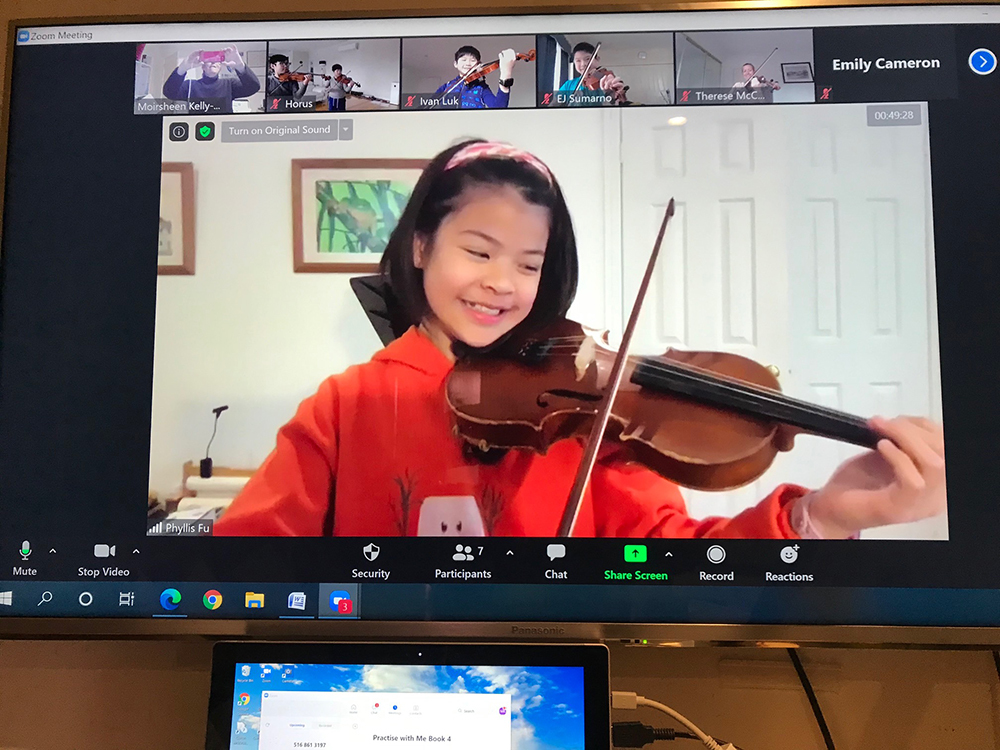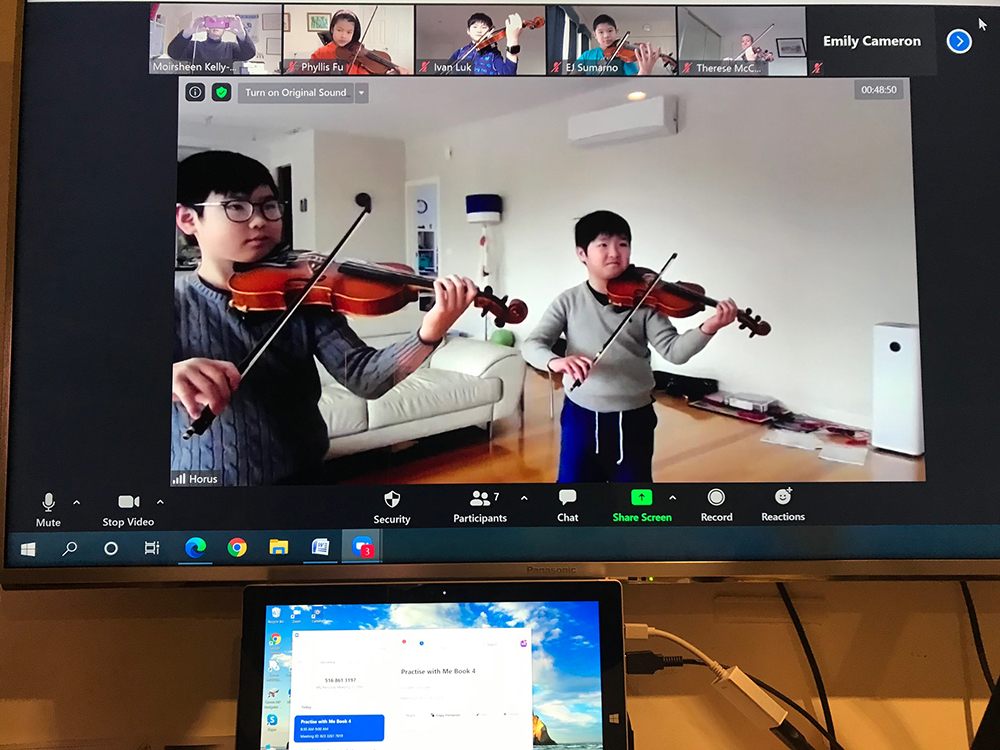ロックダウンから学ぶスズキ・メソード →English
感染拡大への対応
しかし、突然、私たちの計画はすべて頓挫してしまいました。オーストラリアでもコロナウイルスの感染が拡大し、新たな規制が毎日のように課せられました。トリニティ・グラマー・スクールでは、音楽部長が同校のIT部門と調整し、プライベートレッスンで使用するTeamsミーティングアプリの説明会を計画し、システム内の他の様々なアプリやティーチングツールの説明を行ないました。メルボルン・スズキ評議会は、私たちが経験したことのないことを計画するために臨時会議を招集しました。オーストラリア中がロックダウン(都市封鎖)状態になっていました。
このマンスリースズキでは、教室を持つスズキのヴァイオリン科指導者であり、学校を拠点とするスズキのプログラムの管理者でもある私の視点から、ロックダウンの経過をご紹介したいと思います。世界中の先生方やご家族の皆様は、同じようなことを経験されたと思いますし、私たちが直面した問題に対して、より良い解決策をお持ちの方も多いことでしょう。
私は「オンラインレッスンの準備の仕方」のガイドを作成しました。私はそれをトリニティの音楽スタッフと私の生徒全員と共有し、オンラインレッスンの手引きとして使用しました。保護者と生徒は、ノートパソコンの置き場所、写真の額装の仕方、必要に応じて譜面台をどちら側に置くか、照明の向きなどを理解しておく必要がありました。今ではすっかりお馴染みになったことですが、当時は新鮮でした。
それから必要な機材を考えなければなりませんでした。ノートパソコンに付属しているマイクは品質にばらつきがありますが、どれも大抵は外付けマイクにはかなわないので、外付けマイクを引っ張り出してきました。エンジニアの夫が助けに来てくれて、私のITホームサポートクルーになってくれました。彼は自宅のレッスン室の壁にフラットスクリーンテレビを取り付けてくれたので、その日のうちに目を細めずに生徒を見ることができるようになりました。ケーブルを数本用意し、いくつかの家具を移動させ、手の届くところに教本など必需品を置けば準備完了・・・あるいはそう考えることにしました。メルボルンの端っこに住んでいる私のインターネット環境は、不鮮明な画像から、ヴァイオリンとはまったく似ても似つかないスクラッチのようなデジタル音の連続まで、あらゆるものを生み出していました。一部の生徒の家は特に接続速度が遅く、さらに悪化しました。画像が鮮明でなかったり、音と画像がかみ合っていなかったりすると、生徒は新しい曲を勉強するのが大変です。音色やフレージングなどの鈴木鎮一先生からのメッセージを授けることはもとより、弓のアップダウンのような単純なことでさえも、どうやって伝えるか、私は別の方法を考えなければなりませんでした。
学習ポイントを明確にした動画作り
鈴木先生が、「生徒のためには、あらゆる文明の利器を駆使するべきである」とおっしゃっていたのを読んだことを覚えています。私も効果あるものであればなんでも使ってみようとは思っていましたが、実際に生徒に試してみたら、慎重にならざるを得ませんでした。そして多くの先生方がそうされていると思いますが、私はまず動画の作成に取り掛かりました。個別の学習曲について、できるだけ多くのビデオを作りました。また、音作り、ポジション移動、移弦、共鳴、表現、音程などのトピックについてのビデオも作りました。また、様々なレヴェルの生徒に対応できるよう、できる限り多くのトピックに亘り、しかも子どもたちの一日の画面を見る時間が少なくてすむように、できるだけ短いビデオにしました。 これらのグループレッスンスタイルのビデオへのリンクを生徒のニーズに合わせて送信することで、必要とされる学習のポイントを明確にしてあげることができます。
3月から4月にかけては、政府から自宅で仕事をするように指示されましたが、普段学校で教えている場合は、学校の技術サポートや高速のインターネットを利用して、キャンパスに出向いて教えることができました。外出するのは危険な気がしましたが、作ったばかりの動画をアップロードするための高速インターネットが必要な時に限り、学校に出向きました。ただ、学校のネットワークを使っていても、他の部署が昼休みに入った時にはすぐにわかりました。毎日12:50から1:30までの間、私の映像と音声は鮮明に一致し、まるで生徒と一緒に部屋にいるような感覚になりました。
会議もレッスンもオンラインへ
メルボルンのスズキ協会では、生徒の成果を向上させるために、オンラインの指導者会議を何度か開催し、指導者の試行錯誤を共有することにしました。他の音楽教育機関では、専門家を呼んで最新のアプリや最も効果的なアプリを説明する「ハウツー」セミナーを開催していました。しかしある時点で、私は新しいアプリの調査をやめて、ただ教えることに専念しなければなりませんでした。
メルボルンでは9週間ほど「ステイホーム」の規制が行なわれていましたが、その頃から徐々に社会が開放されていきました。もちろん誰もが用心深く、厳格な手順が用意されていました。学校では、親の校内への立ち入りは禁止されていました。生徒と先生は同じ部屋で、親は「Teamsアプリ」を使ってレッスンに参加していました。子どもたちは、最初は気が散っていましたが、すぐに適応できました。子どもたちがレッスンに集中できるように、親がカメラをオフにしたりもしました。トリニティのスズキのコントラバスプログラムでは、楽器を共有するための新しい手順を作る必要がありました。生徒たちは個人のコントラバスを家に置いておき、学校では学校のコントラバスを共有しています。緊急医療の専門家であるフィリス・フー博士の助けを借りて、トリニティの弦楽器部長、テレーズ・マコピン夫人(スズキの指導者でもあります)と私は、ウイルスが硬いものの表面に何日生息していたかを考慮に入れた「ウイルスセーフ・コントラバス・プラン」を作成しました。私はそれをスズキのピアノの指導者に伝え、レッスンの合間にピアノの鍵盤を徹底的に掃除してもらいました。他の楽器は皆自分の楽器を使っています。 グループレッスンでは、生徒同士の距離が離れていなければならず、指導者は生徒の楽器に触れることはできませんでした。朝、登校前に保護者が楽器の調弦をしなければなりませんでした。さらなる調弦は生徒自身で行ない、先生は近くで見ているしかありません。すべてがスローモーションのように感じられましたが、そうするしかありませんでした。
個人の生徒のレッスンは、家への来客制限があったため、オンラインでのレッスンとなりました。私はもっと有意義なレッスンにするにはどうしたらいいかを考えました。ノートパソコンの横には、ロリーや表情に富んだ動物の絵が描かれたカラフルなカードなどを置いて、毎日画面とにらめっこしている子どもたちが退屈しないように、使えるものなら何でも使いました。
突然のロックダウンに
9週間後には、コロナウイルスの最悪の状態は終わったと思っていました。オーストラリアの大部分の地域で、社会活動の再開がうまくコントロールされていましたが、メルボルンでは、事態は制御不能に陥りました。メルボルンは、突然、厳しいロックダウンに移行したのです。自宅から半径5キロ圏外への移動には許可が必要で、午後8時以降の夜間外出禁止令が発令されました。必要不可欠と判断された企業のみが営業を続けることができ、教師は学校のキャンパスに入ることができませんでした。誰もが家にいなければなりませんでした。私たちは新学期に向けての資料の準備を一日でしなければなりませんでした。生徒たちは、本や資料を集めるためだけに学校に来ることが許され、すぐに帰らなければなりませんでした。私たちは、西洋で最も厳しいことになった辛いロックダウンに入ったのです。
生徒のオンライン体験を向上させるために、私は毎週、すべての生徒が演奏のサンプルを録音してオーディオファイルとして私に送ってもらうように、録音スケジュールを作成しました。私は毎週、トナリゼーション、曲の一部、またはピアノ伴奏付きの曲全体を録音するタスクを割り当てました。このシステムは卒業録音の準備にも使われましたが、通常よりもはるかに多くの仕事量となりました。上級者の場合は、具体的な注意点をメールで書いてレッスンでフォロー。毎週送られてくる録音に追いつけるように、ワイヤレスのヘッドフォンを使って庭仕事や料理をしている時にも聴いていました。
1日に4回に分けたオンラインリサイタル
生徒の卒業録音のお手伝いをしたことで、オンラインリサイタルを開催する自信がつきました。リサイタルの時間を30分程度に抑えて生徒たちが画面を見る時間を減らし、1日に4回に分けてリサイタルを開催しました。生徒からは、他のコンサートへの招待を希望され、毎回参加している家族もいました。あるお母さんは仕事で帰らなければならないので、車の中で最後のコンサートを聴いていました。いつものピアニスト、ロードリー・クラークにお願いし、必要な録音をして生徒に送りました。各生徒がどのように曲を演奏するかを想像するのは彼にとって非常に難しいことでしたが、生徒たちはそれを受け入れ、理解してくれました。各家庭には、他の子どもが演奏している間はミュートにしておくように言っておきましたが、演奏が終わったらすぐにミュートを解除して拍手をしてくれました。 オンラインリサイタルは、テレビに出ているようなものなので、各家庭の「ステージ」は慎重に選ばなければなりません。自然な照明、背景の選択、ノートパソコンの配置など、すべてが考慮されました。ピアノの伴奏には全員がポータブルワイヤレススピーカーを使用しており、ヴァイオリンとピアノのバランスを調整するには、ポータブルスピーカーの音量と配置を変えるしかありませんでした。生徒は全員コンサート用の服を着て、自己紹介と作品紹介をしてもらいました。保護者の方が技術的なサポートをしてくださいました(ピアノ伴奏のスタートボタンを操作してもらうのです)。このようなリサイタルでは、ピアノ伴奏のスタートを間違えることを心配する親御さんもいましたが、この新しい形の演奏会に感謝してくださいました。私の教室ではリサイタルの後ではパーティーをするという外せない伝統があり、保護者の方には、子どもたちのがんばりを祝うために、美味しい料理を用意することを忘れないようにとお願いしておきました。これは大変な作業でしたが、努力した甲斐があったと言わざるを得ません。子どもたちは見事に演奏し、一緒に音楽を楽しむことができました。
バーチャルでもともに音楽が楽しめる体験を
モイシーン・ケリー・キーシング先生はスズキ・ヴァイオリンの指導者であり、夫のダグラス、成人した娘のニーブ、2匹の犬マーリーとジギー、猫のキトゥン、2頭の馬コーディとファーギーと一緒にオーストラリア、メルボルンの片田舎に住んでいます。
翻訳には、松本尚三先生(関西地区ヴァイオリン科指導者)にご協力をいただきました。ありがとうございました。
Suzuki Method Lessons from Lockdown
Moirsheen Kelly-Keesing
Melbourne, Australia
Response to the spread of infection
Suddenly, all our plans came to a grinding halt. Cases of the corona virus in Australia were escalating. New restrictions were being imposed on a daily basis. At Trinity Grammar School our Head of Music coordinated with our IT department and planned meetings to explain the Teams meeting app we would use for private lessons, along with various other apps and teaching tools within our system. The Melbourne Suzuki council called an extraordinary meeting to plan for something we never experienced. All of Australia was in lockdown. What follows is my journey through lockdown from the perspective of a private Suzuki violin teacher and an administrator of a school-based Suzuki program. I’m sure all teachers and families world-wide will recognise this journey, and many of you no doubt will have better solutions to the problems we all faced.
I created a guide for ‘how to prepare for an internet lesson’. I shared it with Trinity music staff and all my students for use as protocol for internet lessons. Parents and students needed to understand how to stand in relation to their laptop, where to place the laptop, how to frame the picture, which side to place the music stand if needed, and the direction of lighting. It’s all too familiar with us now, but then it was new.
Then I had to think of the equipment I would need. The microphones which come with laptops are of variable quality, but none are as good as most external microphones so I pulled out my external microphone. My engineer husband came to the rescue and became my IT home support crew. He mounted a flat screen television on the wall of my teaching room at home so I could see students without squinting by the end of the day. With a few extra cables, some shifted furniture, and teaching books and supplies within reach, I was ready. Or so I thought. Being on the fringe of Melbourne our internet speeds produced anything from a slightly grainy picture to a series of scratchy, digitalised sound that didn’t resemble a violin at all. Some student’s homes had particularly bad connection speeds so it became even worse. Students had difficulty studying new works when their picture was not clear or when the sound and picture did not align. I had to figure out another way to communicate the Dr Suzuki’s message of tone, phrasing, and even simple things like bow direction.
Making videos with clear learning points
I remember reading that Dr Suzuki said we have to use all available technology to support our students. Providing it was productive, I wanted to use it, but I was cautious about the results of my experiments on my students. I first set to work making videos as I’m sure many teachers did. I made as many videos as I could on various pieces, but also topics like tone development, shifting, string crossing, resonance, expression, and resonant intonation. I tried to cover as broad a range of topics on many different levels as I could manage, and made the videos as short as possible to reduce the amount of screen time children needed each day. Links to these group class style videos could be sent to target student’s needs to help refocus their practice.
During March and April the government directed us to work from home, however if we normally taught at a school, we could travel to the campus to teach using the much faster internet and technical support from our schools. I felt risky moving through society, but I reserved my trips to school for the times I needed fast internet to upload my newly made videos. Having said that, even using the school’s network I could tell when the other departments stopped for lunch. Every day from 12:50 – 1:30 my picture and sound aligned with great clarity, and it was like I was in the room with the student.
Go online for meetings and lessons
Our Suzuki Association in Melbourne held several online teachers’ meetings to give us a chance to share experiences in the hopes we could improve the outcomes for students. Other music education organisations held ‘how to’ seminars with specialists explaining the latest or most effective apps. After a certain point, I had to stop investigating new apps and just get on with teaching.
‘Stay at Home’ restrictions were in place in Melbourne for 9 weeks at which point society began slowly opening up. Everyone was of course cautious, and strict protocols were in place. In schools parents were not permitted on campus. The student and teacher met in the room together, and the parent attended lessons via the Teams app. While distracting at first, children quickly adapted – or parents simply turned off their cameras to allow children to focus on their lessons. We needed new protocols for shared instruments for Trinity’s Suzuki double bass program. Students kept their personal double basses at home and shared a double bass at school. With the help of Dr Phyllis Fu, Emergency Medicine specialist, the Trinity Head of Strings, Mrs Therese McCoppin (also a Suzuki teacher), and I developed a Covid Safe double bass plan which took into account the number of days the virus germs lived on hard surfaces. I passed information to our Suzuki piano teacher who thoroughly cleaned her piano keys in between lessons. No other instruments were shared We still needed to keep students far apart from each other in group class, and we could not touch each other’s instruments. Parents had to tune instruments in the morning before school. Any adjustments to tuning were done by the student with a teacher watching close by. Everything seemed to happen in slow motion, but it all took place.
Lessons for my private students remained online since restrictions were in place limiting the number of visitors to a house. I searched for ways to make lessons more meaningful. Next to my laptop I kept lollies, colourful cards with pictures of animals expressing emotions - anything which I could use to break the monotony for a child staring at a screen each day.
On sudden lockdown
After nine weeks we thought we were finished with the worst of corona virus, but while the majority of Australia had a well-controlled opening of society, things in Melbourne spiralled out of control. Melbourne moved into a sudden, severe lock down. We needed permission to travel outside of a 5 kilometre radius from home, and an 8 PM curfew came into effect. Only businesses determined to be essential could remain open, and teachers were not permitted on school campuses. Everyone was to stay home. We had one day to prepare and distribute material for the new term. Students were allowed to come to school only to collect books and supplies, then leave. We were going into a hard lockdown which turned out to be one of the most severe in the Western world.
To improve the online experience for students, I created a recording schedule so that each week, every student had some excerpt to record and send to me as an audio file. Each week I distributed tasks to record – a tonalisation study, a portion of their piece, or their entire piece with piano accompaniment. This system was used in the preparation of graduation recordings, although I will admit it created a much larger workload than I would normally have. In the case of advanced students, I would write emails with specific notes and follow up in lessons. I used wireless head phones which I would wear while gardening or cooking so I could keep up with all of the recordings coming in each week.
Four online recitals in one day
Helping students create graduation recordings gave me confidence to hold online recitals. I kept each recital around 30 minutes to reduce student’s screen time which meant my studio had 4 recitals on the same day. Students requested invitations to other concerts with some families attending every concert. One mother had to leave for work, so she listened to the last concert in her car. Our regular pianist, Rhodri Clarke, was hired to make any necessary recordings which he uploaded and sent to students. It was very difficult for him to imagine how each student might perform the pieces, and while indeed a compromise, it was one which the students accepted and understood. Families were all asked to stay on mute while another child performed, but quickly came off mute to applaud. Giving an online recital is a little like being on television, so the ‘stage’ in every home had to be carefully selected. Matters of natural lighting, selecting the right background for the best environment, and the placement of laptops were all considered. The students all used portable wireless speakers for the piano accompaniment, meaning the only way to control the balance between the violin and piano was to vary the volume and placement of the portable speaker. All students were requested to dress in concert clothing, and introduce themselves and their piece. Parents became the technical support crew. (They pushed the button for the piano accompaniment to start.) At these recitals parents were so worried about making a mistake in starting the piano accompaniment, they appreciated the demands of performing in a new way. Our recitals have legendary parties afterwards so parents were asked not to forget to share delicious food to celebrate their children’s hard work. I have to say that while this was a lot of extra work, it was definitely worth the effort. The children played beautifully and really enjoyed the chance to share their music together.
Experience music together in the virtual world
Moirsheen Kelly-Keesing is a Suzuki Violin teacher trainer who lives in the semi rural fringe of Melbourne, Australia with her husband Doug, adult daughter Niamh, their two dogs Marley and Ziggy, their cat Kitten, and two horses Cody and Fergie.













